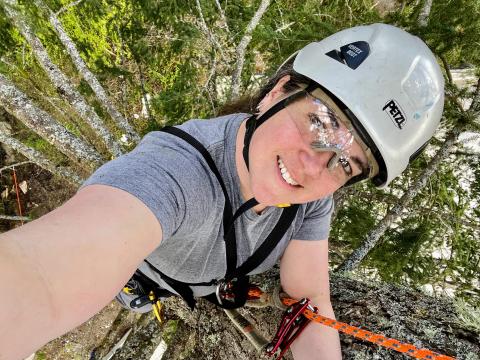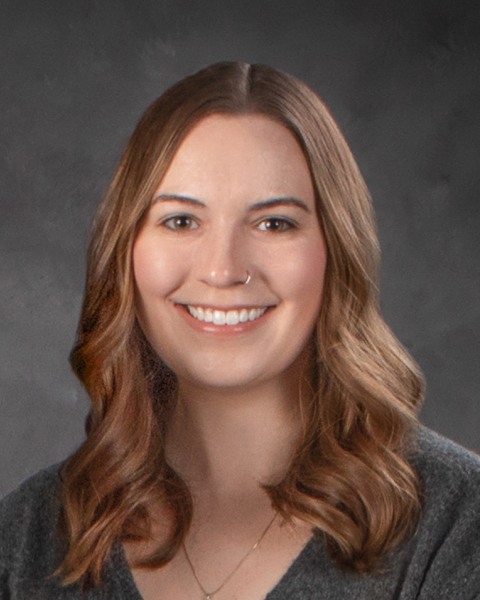In the Woods with Lindsay Watkins, Belknap & Strafford Counties Forester

Extension county foresters help citizens and landowners learn about and care for New Hampshire's forests, trees, wildlife and habitats. Because they're usually in the woods, getting to know your county forester can be a challenge. That's why we've created In the Woods, an ongoing series of interviews with Extension foresters. Get to know your county forester and then give them a call to join you on a walk in the woods.
Name: Lindsay Watkins
Title: Belknap & Strafford Counties Forester, Forest Resources Field Specialist
Start Date at Extension: September 2023
Lindsay was most recently a consulting forester and arborist in the state of Washington, but has New England roots. She worked in New Hampshire as a land steward for The Nature Conservancy and as an environmental educator and outdoor leadership trainer for the Appalachian Mountain Club. She has a strong educational foundation with a Bachelor’s in Natural Resources from Cornell and a Master’s in the Field Naturalist Program from the University of Vermont.
Interested in walking your woodlot with Lindsay? You can contact her at Lindsay.Watkins@unh.edu or 603-749-2529 ext. 704.
What brought you to Extension?
After several years in the Pacific Northwest, I was ready to come back to New England (I lived in New Hampshire for about 8 years previously and also spent 5 years in Boston). The first search I did for forestry-related jobs, the Extension Forest Resources Field Specialist job popped up. As I was reading the job description, I realized it was the perfect combination of forestry and education. A few months later, here I am!
How would your 10-year old self react to what you do?
My 10-year old self would be blown away by what I do. I grew up in suburbia, in Hershey, Pennsylvania; when I was 10, I probably thought foresters were the same as loggers and that cutting down trees was bad. My views on that have obviously evolved! At 10, I don’t think I’d have considered that I might ever run chainsaws, write forest management plans, climb trees, become a certified arborist, and have a job title as cool as “County Forester” in New Hampshire.
What originally got you interested in your current field of work?
I’ve always been a generalist with a lot of interests and a tendency to stumble into cool opportunities, and I’ve always loved being outside. While studying natural resources in college, I discovered I also enjoyed teaching people about cool stuff outside. Since then, my work has included a mix of land stewardship and conservation, outdoor and environmental education, and forestry and arboriculture – I keep coming back to forests and trees and teaching people about forests and trees.
Who is a forester who you look up to or who has inspired you?
I’ve been lucky to work with and learn from so many great foresters, and I have to include a few arborists here too! I might not be doing this work if a college classmate, Shavonne Sargent (SilvaSaunterra LLC) hadn’t asked me to help design her logo and website as she was transitioning from a job in industrial forestry to consulting forestry a few years ago. It was inspiring to play a small part in helping her build her business and having some web design and marketing experience helped me land a job with a small tree care and forestry consulting company in the San Juan Islands, Washington. I learned a ton from my coworkers and colleagues in the Pacific Northwest, especially Michael Case, Colin Blevins, and Scott Baker. On the east coast, a few forestry and arboriculture folks who inspire me are Kristina Bezanson, who coordinates the Arboriculture and Urban Forestry program at UMass, Bear LeVangie and Melissa LeVangie Ingersoll, founders of the Women’s Tree Climbing Workshop, and all of the forestry and wildlife folks at Extension, who’ve already helped me learn so much about being a county forester. Sorry, this isn’t an Oscars acceptance speech, but I owe a lot of thanks to so many amazing people!
What energizes you and brings you excitement?
Being able to connect with people through a shared appreciation for forests and trees and other natural ecosystems, whether that’s landowners, my colleagues, or folks in the forest industry. It’s always fascinating to hear the ideas folks have and dig into what motivates and inspires them.
Which NH tree species is the most underrated or has a bad reputation?
Red maple isn’t a particularly valuable timber species, but no other tree produces such amazing foliage in the fall. Black birch is another species that doesn’t seem to get much attention, but I expect we’ll see it increase in abundance and importance in our forests in coming years, and I love that it smells like wintergreen.
If there was one thing you would want landowners to know, what would it be?
You don’t need to own hundreds or even tens of acres to practice good stewardship. Taking care of wooded areas and even individual trees on a much smaller scale can provide benefits like enhanced wildlife habitat, better stormwater management, decreased soil erosion, energy cost savings, CO2 uptake, aesthetics, and more.
What's one work-related thing you want to accomplish in the next year?
I’m really looking forward to the Women Landowner Summit, part of Extension’s Women in the Woods program. I’m moderating a panel, which is something I’ve never done before and feels like a big responsibility, so I’m excited to see how it goes!
What’s the funniest thing that’s happened to you in the woods or the coolest/memorable moment?
In grad school, I was doing some forest health and dendrochronology research on inventory plots in Vermont. One of my first days of field work, I was out in the woods with Sandy Wilmot from the Vermont Department of Forests Parks and Recreation and we were parked at the end of a long forest road. A WILD thunderstorm blew through and knocked over several large trees, completely blocking the road. We had to hike out to get a cell phone signal and call for help clearing the road. When I told my advisor about it later, she asked why I didn’t have a chainsaw in my car. That’s when I realized it was time to learn some new skills!
What are you looking forward to in the coming months?
After living amidst conifers in the Pacific Northwest for the last several years, I’m looking forward to a New England spring – specifically the emergence of maple blossoms, the very specific shade of green of new leaves, and ephemeral forest wildflowers. Before that though, I really hope we get some good snow up in the mountains.
What’s your favorite way to spend a weekend?
Depending on the season and the weather, mountain biking, snowboarding, paddleboarding, hiking, and hanging out with friends and family, especially my niece and nephew.
If you suddenly became a master at woodworking, what would you make?
I’ve always wanted a big live-edge slab table but I currently live in a very small apartment. To accommodate my table, I’d have to start by building myself a sweet little house. Nothing too big or fancy, just a solid, cozy, efficient, modern cabin with lots of wood, big windows, and a great woodstove with a built-in pizza oven.
If you had to describe yourself as a forest animal, which one would it be?
I think it would be an American Marten. Like martens, I enjoy mixed deciduous and conifer forests with a variety of horizontal and vertical structure, especially higher-elevation spruce-fir forests in the White Mountains. Martens are small, cute, and curious, but like other members of the weasel family, they also have a spicy side and can be fierce and tenacious. I’m not as good at climbing trees as martens, but I’d like to be!
What's your favorite ice cream flavor?
This might be the hardest question on this list. My unranked top 3 include Cornell Dairy’s Clocktower Pumpkin, Lopez Island Creamery’s Blueberry Lavender, and Ben & Jerry’s Americone Dream, but I’m always happy with a good vanilla in a waffle cone with gummy bears.
What was the last book you read or movie you saw?
Not including field guides and YouTube videos of logging operations, I think it was actually the Barbie movie. I wasn’t going to admit that, but I enjoyed it. I grew up playing with Barbies (along with Teenage Mutant Ninja Turtles) so the movie was nostalgic and it resonated. It can be hard to be a woman, especially but not exclusively in fields that are still male-dominated, and some of the jokes and especially America Ferrera’s monologue really nailed it. (On a related note: shout-out to forest canopy ecologist Nalini Nadkarni for her original “TreeTop Barbie” and the National Geographic Barbies she inspired!)
Which meal is your favorite: breakfast, lunch, or dinner?
Breakfast, any time of day. I’m a huge fan of fried eggs, hash browns, and really good sourdough or cinnamon raisin toast. As a Pennsylvanian, I also love scrapple. If you’ve never had it and you like pork, try it. Don’t read the ingredients, just get some Habbersett’s, fry it up, add some ketchup, and enjoy.
Where is the most interesting place you’ve been?
I had the opportunity to spend a semester in the Galapagos Islands in college. It’s hard to think of a more perfect place to study ecology and evolutionary biology. The wildlife is incredible - from marine iguanas to tortoises to penguins. The finches are pretty cool too, I suppose!
What’s something you like to do the old-fashioned way?
As an unashamed “elder Millennial” and technophile, there’s not much I do the old-fashioned way, but I learned to fell trees with a crosscut saw and ax before I really got proficient with a chainsaw and it’s incredibly satisfying. I haven’t done it in a while, but I’d like to again.

